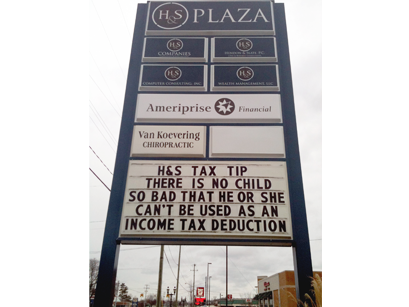In the News: Couple Loses $18.5 Million Deduction on Technicality

If you donate noncash items to charity, make sure you file the proper paperwork, or you could lose your deduction.
A blog on the Wall Street Journal recently ran a story about a couple who lost an $18.5 million charitable contribution deduction because they failed to include the correct paperwork at the time they filed their tax return. Below is a summary of what happened, or visit the WSJ blog to read California Couple Loses $18.5 Million Charitable Deduction on Technicality by Laura Saunders.
- The Sacramento couple donated property, which they valued at $18.5 million, to charity
- The IRS challenged the value, and the couple hired an outside appraiser to asses the property (which he valued at $20.3 million)
- The couple lost the right to the deduction because a.) they didn’t attach the appropriate paperwork at the time they filed, b.) the taxpayer wasn’t a qualified appraiser, c.) the independent appraiser was not hired in a timely fashion (from the time they filed)
This story is unfortunate because the couple lost on a technicality, but it reminds us how important it is to follow the IRS reporting guidelines. Below are record keeping guidelines to keep in mind for noncash donations:
Information to Keep
- Name of the charitable organization
- Date and location of the contribution
- A reasonable, detailed description of the property you contributed
- The fair market value, as well as, the method you used to determine the value
- Cost or other basis of the property
- Although it is not required, it is a good idea to keep photographs of the items donated (ie if you donate 10 items to Goodwill, photograph the 10 items before you drop them off)
If the donation is worth less than $250
- Keep a receipt or similar documentation, unless you are unable to obtain such information (ie you brought your donation to an unattended drop-off site)
If the donation is worth $250-$500
- You will need written acknowledgement from the organization, containing the following information: name and address of the organization, date and location of the contribution, description of the property, as well as, whether any ‘perks’ were provided to the donor and the fair market value of ‘perks’
If the donation is worth $501-$5000
- The same requirements as $250-500 level apply, as well as, records indicating how the property was obtained, the date it was acquired, and the adjusted basis of the property
Remember, the forms and reporting guidelines are complicated and vary based on what you are donating/ how much it is worth. The IRS is starting to crack down more on charitable contributions, so as you make donations throughout the year, be sure to keep the appropriate documentation. If you have any questions, contact an H&S tax professional.
Sources:
2011 Quickfinder (Tax Regulation Guide)
California Couple Loses $18.5 Million Charitable Deduction on Technicality by Laura Saunders








